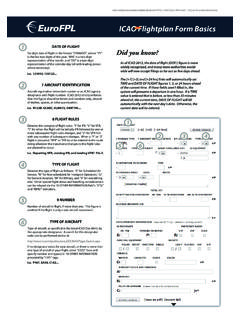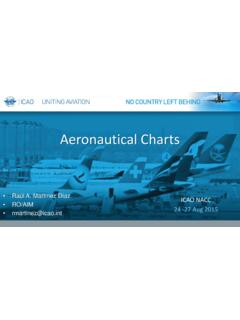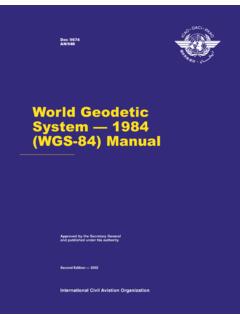Transcription of ICAO Flightplan Form Basics - EuroFPL
1 icao Flightplan Form BasicsSome verbiage and examples adapted directly from PANS-ATM icao Doc 4444 Amdt 1. For EuroFPL use and reference of icao 2012, the date of ight (DOF/) gure is more widely recognized, and many more authorities world-wide will now accept lings as far out as ve days [+1] [+3] and [+24 hrs] links will automatically set TIME and DATE OF FLIGHT gures 1, 3, or 24 hours ahead of the current time. If these elds aren t lled in, the system will presume a departure in one hour. If a TIME value is entered that is before, or less than 30 minutes ahead of, the current time, DATE OF FLIGHT will ll automatically with the next day s date. Otherwise, the current date will be you know? 121015, date of ight in the format YYMMDD , where YY is the last two digits of the year, MM is a two-digit representation of the month, and DD is a two-digit representation of the calendar day (all with leading zeroes where necessary).
2 DATE OF N123B, GCABC, KLM672, registration letters/tail number or an icao agency designator with ight number. icao 2012 strictly enforces that this gure should be letters and numbers only, devoid of dashes, spaces, or other AIRCRAFT Departing VFR, cruising IFR, and landing VFR? File P46T, EA50, the category of ight rules: I for IFR, V for VFR, Y for when the ight will be initially IFR followed by one or more subsequent ight rules changes, and Z for VFR rst with any number of subsequent changes. When a Y or Z ight is prepared, VFR or IFR must be entered in the route string wherever the transitions/changes to the ight rules are planned to FLIGHT RULESType of aircraft, as speci ed in the latest icao Doc 8643, by the appropriate designator. A search for this designator code can be performed online at:If no designator exists for your aircraft, or there is more than one type of aircraft in your ight, enter ZZZZ here and specify number and type(s) in 18 OTHER INFORMATION preceded by TYP/ OF AIRCRAFTN umber of aircraft in ight, if more than one.
3 This gure is omitted if the ight is only a solo aircraft NUMBERD enotes the type of ight as follows: S for Scheduled Air Service, N for Non-scheduled Air Transport Operation, G for General Aviation, M for Military, and X for everything else. Other special ight status and handling considerations can be relayed via the 18 OTHER INFORMATION eld s STS/ and RMK/ OF FLIGHT112233445566 Flightplan Form BasicsSome verbiage and examples adapted directly from PANS-ATM icao Doc 4444 Amdt 1. For EuroFPL use and reference nature and scope of the [ icao 2012] amendment is to update the icao model ight plan form in order to meet the needs of aircraft with advanced capabilities and the evolving requirements of automated air tra c manage-ment (ATM) systems, while taking into account compat-ibility with existing systems, human factors, training, cost and transition aspects." icao State Letter (AN 13 ) - 25 June 2008 Did you know?
4 Wake turbulence category of aircraft as speci ed in icao Doc 8643 or based on weight and the following options: L for Light (< 7,000 kg), M for Medium (7,000 to 136,000 kg), H for Heavy (> 136,000 kg), and J for Jumbo (exceptionally heavy aircraft such as the Airbus A380-800). A search for the category can be performed online at:WAKE TURBULENCE icao 2012 amendment includes extensive changes to the COM/NAV equipment codes used in the FPL message format. These changes and EuroFPL s helpful icao 2012 Equipment Wizard are explained in-depth on the next page (Page 3) of this brie EKRK, BIKF, LFPG, CYYR, 0615, 1342, K0830, N0485, F330, M0840, location indicator of the departure aerodrome, AFIL if led in the air, or ZZZZ if no o cial designator exists in icao Doc 7910. In the latter cases, icao 2012 strictly states that the aerodrome name or primary x with location (degrees and minutes ddmmNdddmmE format preferred) be entered in 18 OTHER INFORMATION preceded by a DEP/ DEPARTURE AERODROMEP lanned cruising level for the initial or whole cruise segment of the ight, indicated as: F for Flight Level in 100s of feet, A for plain altitude in 100s of feet (both three-digit), S for Standard Metric Level in tens of metres, M for plain altitude in tens of metres (both four-digit), or V for uncontrolled VFR (number eld left blank).
5 LEVELTrue airspeed for the initial or whole cruise segment of the ight, indicated as: N for Knots, followed by a four-digit gure, M for Mach number followed by a three-digit representation of ratio, or K for Kilometers/hour followed by a four-digit CRUISING SPEEDP lanned time of departure (UTC) in 24-hour HHMM format, where HH is a two-digit representation of the hour, and MM is a two-digit representation of the minutes past the hour (with leading zeroes where necessary).TIME112233445566 Flightplan Form Basics10 EQUIPMENT -- EuroFPL icao 2012 Equipment WizardThe Equipment Wizard aims to provide users with an organized graphical interface for the many equipment designators employed in this new format. Input can be achieved by typing codes directly into the text elds, or by selecting the checkboxes for equipment carried. NIL can be selected under either column to signify that there is no equipment and/or surveillance capability for the aircraft.
6 Clicking the + option will reveal the various items as follows:VHF RTF/VOR/ILS (S) - Standard COM/NAV SetupGBAS (A) - Ground Based Augmentation SystemLPV (APV/SBAS) (B) - Localizer Performance withVertical Guidance (Infers Augmentation)LORANC (C) - LORAN-C RadionavigationDME (D) - Distance Measurement EquipmentADF (F) - Automatic Direction FinderGNSS (G) - Global Navigation Satellite SystemHF RTF (H) - HF RadiotelephoneINERTIAL NAV (I) - Aircraft Inertial GuidanceCPDLC (Multiple) - Controller-Pilot Data LinkATC RTF SATCOM (Multiple) - Radiotelephone (K) - Microwave Landing SystemILS (L) - Instrument Landing SystemVOR (O) - VHF Omnidirectional Radio RangePBN (R) - Performance-Based NavigationTACAN (T) - Tactical Air Navigation SystemUHF RTF (U) - UHF RadiotelephoneVHF RTF (V) - VHF RadiotelephoneRVSM (W) - Reduced Vertical Separation MinimumMNPS (X) - Minimum Navigation Performance (Y) - kHz Radio Channel SpacingOTHER (Z) - Other Item(s)
7 Not Listed AboveMODE A (A) - Mode A TransponderMODE S (S) - Mode S TransponderADS-B/1090 MHz (Multiple) -1090 MHz Out/InADS-B/UAT (Multiple) - Universal Access Trans. Out/InADS-B/VDL M4 (Multiple) - VHF Digital Mode 4 Out/InADS-C/FANS 1/A (D1) - Sur. Contract Future Air (G1) - Sur. Contract Aeronautical TelecomMODE A/C (C) - Mode A Transponder with Mode CS/[..] (Multiple) - Mode S Transponder with or - Aircraft IdentificationADS-B - Surveillance BroadcastDLINK - Data LinkPALT - Pressure AltitudeACARS (Multiple) - Addressing and Reporting * New indicators added to describe complex compliment items.* The S indicator VHF RTF/VOR/ILS is no longer inclusive of ADF.* If PBN is speci ed, Field 18 requires corresponding PBN/ data.* If OTHER is speci ed, Field 18 requires COM/ , NAV/ , or DAT/ .For a good overall online reference see also:Key Changes:GNSS augmentation NAV/ data in Field 18 requires corresponding PBN/ data in Field requires corresponding COM/ , NAV/ or DAT.
8 EQUIPMENTSURVEILLANCEICAO Flightplan Form BasicsSome verbiage and examples adapted directly from PANS-ATM icao Doc 4444 Amdt 1. For EuroFPL use and reference you don't enter a TOTAL EET gure, a temporary gure is automatically calculated upon STORE/UPDATE that is based on great circle distance and basic cruise speed (no winds) to allow for easy validation of the ightplan. After running a navigation log, a more accurate TOTAL EET gure can be entered along with EET/ entries in the 18 OTHER INFORMATION eld where appropriate. Did you know?A string of points (and connecting airways or DCTs where applicable) describing an ATS route or path of xes no more than 30 minutes ying time or 200nm apart, including those points where a change of speed, level, track, or ight rules is planned. Points can be listed by their coded designator ( LN, MAY, HADDY), a 7 or 11-character representation of their coordinates ( 46N078W, 4620N07805W), or a point relative to a reference point based on bearing and distance ( DUB190040 being 40nm out on the 190 degree magnetic bearing from DUB).
9 Change of speed and/or level is indicated by appending data formatted as in 15 CRUISING SPEED and LEVEL to a point, after a slash ( MAY/N0305F180, 46N078W/M082F330). Change of ight rules are shown by a standalone VFR or IFR to indicate the beginning of that phase of location indicator of the destination aerodrome or ZZZZ if no o cial designator exists in icao Doc 7910. In the latter case, icao 2012 strictly states that the aerodrome name or nal x with location (degrees and minutes ddmmNdddmmE format preferred) be entered in 18 OTHER INFORMATION preceded by a DEST/ DESTINATION 0142, 0305, EKRK, BIKF, LFPG, CYYR, EKRK, BIKF, LFPG, CYYR, 0142, 0305, estimated enroute time in HHMM format, where HH is a two-digit representation of the hours and MM is a two-digit representation of minutes in ight (with leading zeroes where necessary).TOTAL EETT otal fuel endurance in HHMM format, where HH is a two-digit representation of the hours and MM is a two-digit representation of minutes of fuel (with leading zeroes where necessary).
10 19 ENDURANCEThe icao 2012 amendment includes extensive changes to the way data is presented and ordered for Field 18 data in the FPL message format. These changes and EuroFPL s helpful icao 2012 Other Information Wizard are explained in-depth on the next page (Page 5) of this brie OTHER INFORMATIONFour-character location indicator of the alternate aerodrome(s) or ZZZZ if no o cial designator exists in icao Doc 7910. In the latter case, icao 2012 strictly states that the aerodrome name(s) with location (degrees and minutes ddmmNdddmmE format preferred) be entered in 18 OTHER INFORMATION preceded by a ALTN/ tag.(2ND) ALTN AERODROME112233445566 icao Flightplan Form Basics18 OTHER INFORMATION -- EuroFPL icao 2012 Other Information * For IFPS Flights Only* New indicators have been introduced, some retracted.* The sequence that indicators should appear in is now compulsory.* Any given indicator can only appear ONCE in Field 18.



